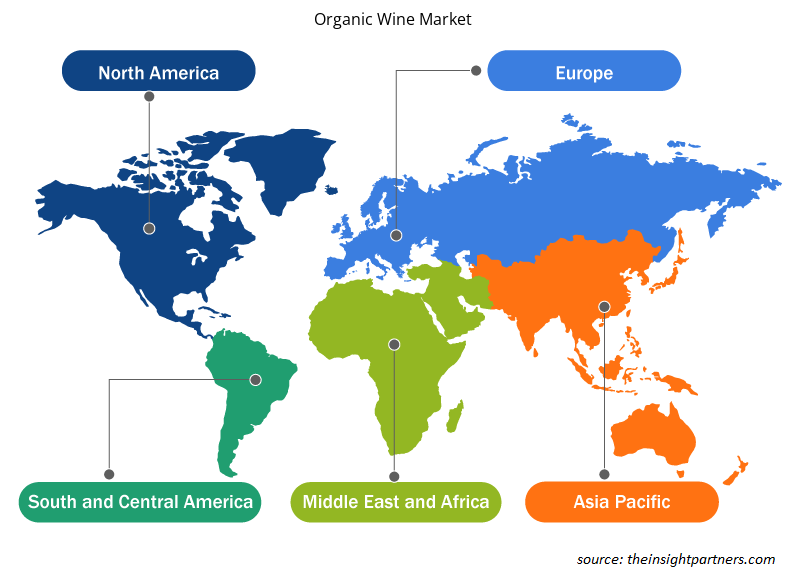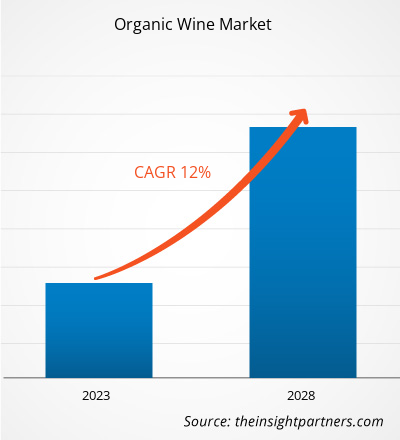有机葡萄酒市场规模预计将从 2022 年的 124.712 亿美元增至 2028 年的 245.5714 亿美元。预计 2022-2028 年期间的复合年增长率为 12.0%。
市场的增长归因于消费者对有机和可持续食品和饮料的快速增长的偏好。如今,人们的生活方式和社会价值观发生了变化,这推动了对有机饮料(例如有机葡萄酒)的需求。数字技术使他们能够获得各种产品,进一步刺激了对有机葡萄酒的需求。有机葡萄酒有多种口味和包装;例如,红葡萄酒、白葡萄酒和玫瑰葡萄酒被包装在不同大小的瓶子和罐子里,这增加了消费者的选择。此外,政府越来越多地支持可持续农业的举措导致有机葡萄酒产量增加。有机葡萄酒的供应量增加和对产品优势的认识大大促进了对有机葡萄酒的需求。2021年,欧洲占据了全球有机葡萄酒市场
的主要份额。然而,预计北美在预测期内的市场复合年增长率最高。北美的有机葡萄酒市场分为美国、加拿大和墨西哥。按数量计算,美国是葡萄酒的主要消费国之一。根据联合国发布的数据,该国的有机葡萄园数量也在不断增加,并且从欧洲进口了大量葡萄酒。
定制此报告以满足您的需求
您可以免费定制任何报告,包括本报告的部分内容、国家级分析、Excel 数据包,以及为初创企业和大学提供优惠和折扣
-
获取此报告的关键市场趋势。这个免费样品将包括数据分析,从市场趋势到估计和预测。
COVID-19 疫情对有机葡萄酒市场的影响
由于封锁时间延长、制造单位停工、旅行限制、国际贸易禁令、供应链中断以及原材料供应短缺,COVID-19 疫情严重影响了制造业的运营效率。这最终阻碍了有机葡萄酒市场的发展。疫情导致经济放缓,食品和饮料行业也因此受到干扰,这也阻碍了市场的增长。然而,随着各国放松先前实施的限制措施,企业已经恢复。暂时的中断和随后的恢复,导致有机葡萄酒市场实现了高速增长。
多个国家的政府推出 COVID-19 疫苗,进一步缓解了这种情况,导致全球商业活动增加。此外,一些国家的政府正计划开发现代化和技术先进的基础设施,以减轻 COVID-19 疫情对经济的影响。在封锁期间,消费者自己购买葡萄酒,而不是从酒店、餐馆和酒吧购买,这导致有机葡萄酒的销量大幅增长。因此,尽管 COVID-19 疫情产生了不利影响,但预计未来几年有机葡萄酒市场将大幅增长。
市场洞察
消费者对有机产品的偏好日益增长
有机葡萄酒越来越受欢迎,因为它是由符合有机农业规范的葡萄酿造的。政府机构不允许在生产过程中使用人工和化学肥料、杀菌剂、杀虫剂和除草剂。有机葡萄酒更健康,因为它含有许多抗氧化剂、维生素和矿物质。红酒中的白藜芦醇有助于降低胆固醇和预防癌症。美国农业部有机产品、Demeter 和 Eco Cert 等多个组织都在规范和支持有机葡萄酒的生产。
基于类型的洞察
根据类型,全球有机葡萄酒市场规模分为静止葡萄酒和起泡葡萄酒。2021 年,静止葡萄酒占据了更大的市场份额。然而,在预测期内,起泡葡萄酒市场预计将以更高的复合年增长率增长。大多数静止葡萄酒都是为立即饮用而开发的,而少数葡萄酒是为了在最佳酒窖条件下瓶装陈酿而制造的。这些静止有机葡萄酒是由发酵后的葡萄汁制成的。此外,由于有各种带有香料和水果气味的变体可供选择,静止有机葡萄酒预计将出现高需求。因此,静止有机葡萄酒市场预计将在预测期内增长。
Avondale、Elgin Ridge Wines、Kendall-Jackson、The Organic Wine Company、Bronco Wine Company、King Estate Winery、Grgich Hills Estate、Emiliana Organic Vineyards、Società Agricola Querciabella Spa 和 Frey Vineyards 是有机葡萄酒市场的参与者。这些公司为市场提供了广泛的产品组合。这些公司在发展中地区都有业务,这为市场提供了有利可图的机会。市场参与者正在开发高质量、创新的产品以满足客户要求。
有机葡萄酒市场区域洞察
Insight Partners 的分析师已详细解释了预测期内影响有机葡萄酒市场的区域趋势和因素。本节还讨论了北美、欧洲、亚太地区、中东和非洲以及南美和中美洲的有机葡萄酒市场细分和地理位置。

- 获取有机葡萄酒市场的区域特定数据
有机葡萄酒市场报告范围
| 报告属性 | 细节 |
|---|---|
| 2022 年市场规模 | 124.7亿美元 |
| 2028 年市场规模 | 245.6亿美元 |
| 全球复合年增长率(2022 - 2028) | 12.0% |
| 史料 | 2020-2021 |
| 预测期 | 2023-2028 |
| 涵盖的领域 |
按类型
|
| 覆盖地区和国家 |
北美
|
| 市场领导者和主要公司简介 |
|
有机葡萄酒市场参与者密度:了解其对商业动态的影响
有机葡萄酒市场正在快速增长,这得益于终端用户需求的不断增长,而这些需求又源于消费者偏好的不断变化、技术进步以及对产品优势的认识不断提高等因素。随着需求的增加,企业正在扩大其产品范围,进行创新以满足消费者的需求,并利用新兴趋势,从而进一步推动市场增长。
市场参与者密度是指在特定市场或行业内运营的企业或公司的分布情况。它表明在给定市场空间中,相对于其规模或总市场价值,有多少竞争对手(市场参与者)存在。
在有机葡萄酒市场运营的主要公司有:
- 凯洛格公司
- 埃文代尔
- 埃尔金岭葡萄酒
- 肯德尔-杰克逊
- 有机葡萄酒公司
免责声明:上面列出的公司没有按照任何特定顺序排列。

- 了解有机葡萄酒市场顶级关键参与者概况
报告亮点
- 有机葡萄酒市场的渐进式行业趋势可帮助参与者制定有效的长期战略
- 发达市场和发展中市场采用的业务增长战略
- 2020 年至 2028 年有机葡萄酒市场的定量分析
- 全球有机葡萄酒需求量估计
- 波特的五力分析说明了行业中买家和供应商的效力
- 了解竞争市场状况的最新发展
- 市场趋势和前景以及推动和制约有机葡萄酒市场增长的因素
- 通过强调支撑商业利益的市场策略来协助决策过程,从而促进市场增长
- 不同节点的有机葡萄酒市场规模
- 市场的详细概述和细分,以及有机葡萄酒行业动态
- 各地区有机葡萄酒市场规模及增长潜力巨大
“2028 年全球有机葡萄酒市场分析”是一项针对食品和饮料行业的专业深入研究,特别关注全球有机葡萄酒市场趋势分析。该报告旨在通过详细的市场细分提供市场概述。有机葡萄酒市场
分为类型、包装类型、分销渠道和地理位置。根据类型,市场分为静止葡萄酒和起泡葡萄酒。根据包装类型,市场分为瓶装和罐装。根据分销渠道,市场分为超市和大卖场、专卖店、在线零售和直销。按地理位置划分,市场大致分为北美、欧洲、亚太地区 (APAC)、中东和非洲 (MEA) 以及南美洲和中美洲。
公司简介
- 埃文代尔
- 埃尔金岭葡萄酒
- 肯德尔-杰克逊
- 有机葡萄酒公司
- 野马葡萄酒公司
- 国王酒庄
- 格吉奇山庄园
- Emiliana 有机葡萄园
- Società Agricola Querciabella Spa 农业公司
- 弗雷葡萄园
- 历史分析(2 年)、基准年、预测(7 年)及复合年增长率
- PEST和SWOT分析
- 市场规模、价值/数量 - 全球、区域、国家
- 行业和竞争格局
- Excel 数据集
近期报告
相关报告
客户评价
购买理由
- 明智的决策
- 了解市场动态
- 竞争分析
- 客户洞察
- 市场预测
- 风险规避
- 战略规划
- 投资论证
- 识别新兴市场
- 优化营销策略
- 提升运营效率
- 顺应监管趋势























 获取免费样品 - 有机葡萄酒市场
获取免费样品 - 有机葡萄酒市场